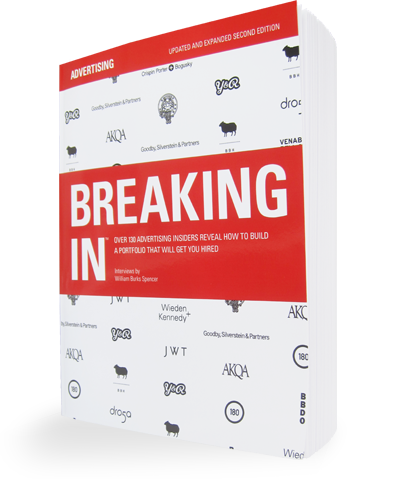In case you missed it, check out some of Ari’s work here.
[Interviewed at Crispin Porter + Bogusky, Miami]
AM: …I want to be surprised and entertained when I look at your book. First, I want to know that you know how to engage an audience. After that, I want to see that you have a good understanding of the people you are trying to reach. If the book has both of those things, then yeah, I’m impressed. You’ve managed to get my attention, and at the same time, demonstrate just how insightful you can be. You’ll probably be getting a phone call. But then, if your clever, insightful book is also a well-crafted one, you’ll have this creative director at your doorstep on his knees, begging you to come work with him.
WS: How important is finish? If ideas are the most important thing, can
sketches be enough? Do you look at actual books anymore, or is it all
websites?
AM: Back in the day, I remember spending hundreds of dollars on
thick laminations and felt backings, so as not to scratch the laminations,
for each one of the ads in my book. Today, such an expense is highly
unadvisable, given the opportunities you have to present yourself digitally.
Online portfolios and PDFs are faster, more efficient, and cheaper to
produce and send. Your student work won’t stay in your book forever, so
don’t bother with the fancy portfolio case. There’s no need to spend all
that money on packaging. Spend it on important things like food, rent, and
finding out Gerry Graf’s home address.As for your ideas, well, that’s another story. The care and thoughtfulness
you put into executing your work matters. Every ad is an opportunity to
show your love for your craft. And no, it doesn’t mean I won’t take your
book seriously if it’s made out of cocktail napkins. I’ll probably look at
that one too. But it does help to know you take your work seriously. Well-
crafted writing and art direction say a ton about your talent and work
ethic. And to be honest, nobody has ever sent me a book made from
napkins.
WS: How important is copy? Do you need to see long-copy ads?
AM: The question is, “Would the audience you’re trying to reach
appreciate or require long copy to get the message of your campaign?”
If the answer is yes, then I might need to see long-copy ads. Otherwise,
shorter copy, headlines, and samples of your writing will most likely
be enough to let me know you’ve got the goods. Besides, I’m far more
interested in a writer’s ability to create a seamless marriage of words and
images. My first creative director, the late ad legend Diane Rothschild,
once created an ad for the Range Rover that showed the vehicle driving
speedily through a shallow pond. The headline read, “We brake for fish.”
Always remember the first rule of copywriting: less is more.
WS: What do you think of showing work that is not advertising?
AM: Personally, I love it when candidates have blogs. The ideas and
thoughts you share about yourself can often tell me more about the
way you think than any ad in your book. On the flip side, blogs have
turned me off from certain candidates even though their work was
stellar. Everything you show is a window into your personality. In that
way, yes, photography, art, and writing can give you a great edge on the
competition. Or not.
WS: Do you have any other advice for a student or junior trying to get
into the business, either in putting together a book or how to actually
start looking for jobs?
AM: These are strange days for our business. Massive shifts are taking
place and nobody is entirely sure what the agency of the future will look
like. I imagine there’s a ton of pressure on students to demonstrate their
ability to keep up with everything new. But proceed with caution here.
Sometimes, the best idea isn’t about new media, it’s simply a new idea.
There’s no substitute for a smart human insight. So rather than treating
your book like an emerging-media check box, think about your audience
and what place your client’s brand has in their lives. Think about ways for
brands to add real value to real people.Also, consider the fact that you’ll be competing with hundreds of portfolio
school students who have presumably given a great deal of thought to
self-promotion. So don’t be afraid to be yourself. We go into this business
because we think differently than other people. Have faith that your
difference will be appreciated, welcomed, and, ultimately, celebrated…

Comments are closed.